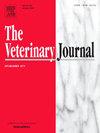尿路上皮癌犬的尿脂生成
IF 3.1
2区 农林科学
Q1 VETERINARY SCIENCES
引用次数: 0
摘要
犬尿路上皮癌(cUC)是一种在犬中普遍存在的侵袭性恶性肿瘤。目前的治疗方法效果有限,诊断延误往往令人担忧。cUC的独特之处在于它对环氧化酶(COX)抑制剂表现出高反应性,并且在BRAF中具有高频率的单核苷酸突变,称为BRAFV595E。COX是参与脂质介质产生的关键酶之一,脂质介质调节各种疾病的进展。虽然研究已经揭示了COX在cUC中的作用,但脂质介质的产生谱仍然未知。在本研究中,我们采用液相色谱-串联质谱法全面测量cUC犬的尿脂介质水平。我们发现cUC的脂质生成发生了改变,几种cox催化的脂质(包括前列腺素E2和血栓素B2)和几种脂氧合酶催化的脂质(包括白三烯E4)的数量增加。此外,我们发现BRAFV595E突变倾向于增加大多数酶产生的脂质水平。我们的研究结果为cUC和BRAF突变的癌症提供了新的治疗和诊断策略。本文章由计算机程序翻译,如有差异,请以英文原文为准。
Urinary lipid production in dogs with urothelial carcinoma
Canine urothelial carcinoma (cUC) is a prevalent and aggressive malignancy in dogs. Current treatments have limited effectiveness, and delays in diagnosis are often a concern. cUC is unique in that it shows high responsiveness to cyclooxygenase (COX) inhibitors and has a high frequency of a single nucleotide mutation in BRAF, known as BRAFV595E. COX is one of the key enzymes involved in the production of lipid mediators, which regulate the progression of various diseases. Although studies have revealed the roles of COX in cUC, the production profiles of lipid mediators remain unknown. In this study, we comprehensively measured the urinary lipid mediator levels of cUC dogs using liquid chromatography-tandem mass spectrometry. We found that lipid production was altered in cUC, with increased amounts of several COX-catalyzed lipids, including prostaglandin E2 and thromboxane B2, and several lipoxygenase-catalyzed lipids, including leukotriene E4. Additionally, we found that the BRAFV595E mutation tended to increase the levels of most enzymatically produced lipids. Our results provide insights into novel therapeutic and diagnostic strategies for cUC and cancers with BRAF mutations.
求助全文
通过发布文献求助,成功后即可免费获取论文全文。
去求助
来源期刊

Veterinary journal
农林科学-兽医学
CiteScore
4.10
自引率
4.50%
发文量
79
审稿时长
40 days
期刊介绍:
The Veterinary Journal (established 1875) publishes worldwide contributions on all aspects of veterinary science and its related subjects. It provides regular book reviews and a short communications section. The journal regularly commissions topical reviews and commentaries on features of major importance. Research areas include infectious diseases, applied biochemistry, parasitology, endocrinology, microbiology, immunology, pathology, pharmacology, physiology, molecular biology, immunogenetics, surgery, ophthalmology, dermatology and oncology.
 求助内容:
求助内容: 应助结果提醒方式:
应助结果提醒方式:


